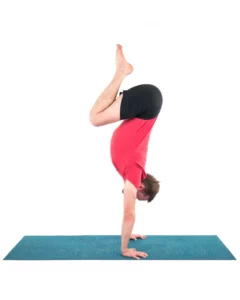Does Yoga Help You Adapt Better to Stress? Charting Yoga’s Effects on Heart Rate Variability

Heart rate variability is increasingly acknowledged as a health variable that can offer insights into how healthy you are and how well you deal with stress. Learn more about this important biomarker and preliminary studies on how it is affected by yoga practice.
Did you know that your overall health and wellbeing may be determined, in part, by how flexibly your heart rate adapts to your breath? It’s a phenomenon referred to as heart rate variability (HRV).
Heart Rate Variability and Stress
HRV is a biomarker that measures how well your body adapts to stress. Because we know yoga is linked to increased stress resilience, HRV seems to be a natural target for yoga research. But so far the links between yoga and HRV are inconclusive according to a systematic review of the research published in Applied Psychophysiological Feedback.
Heart rate variability (HRV) is a general indicator of autonomic nervous system function. It is reported using several different metrics: high frequency (HF-HRV), a measure of parasympathetic nervous system activity, low frequency (LF-HRV), a measure of sympathetic nervous system activation, and LF:HF ratio, a measure of parasympathetic and sympathetic nervous system balance.
HRV is measured by examining the amplitude of respiratory sinus arrhythmia (RSA) variability. RSA variability is an indicator of the rhythmic increase and decrease in heart rate that naturally occurs as you inhale and exhale. Inhalation is associated with a slight heart rate acceleration, and exhalation with a slight deceleration. This oscillation between acceleration and deceleration takes place due to the synchronous activation of both the sympathetic (SNS) and parasympathetic (PNS) nervous system.
Research consistently links greater RSA variability to a variety of positive health outcomes including the ability to effectively respond effectively to increasing metabolic and environmental demands. In other words, higher HRV may serve as a protective factor against stress, and stress-related illness.
HRV variability can be challenged by chronic stress and prolonged negative emotional states, which cause an imbalance in the autonomic nervous system. Generally speaking, your sympathetic nervous system, which is like your physiological gas pedal, gets stuck in overdrive, which is reflected in low HF-HRV or high LF-HRV.
As you might expect, both forms of HRV are linked to a number of conditions including depression, anxiety, substance use/abuse, eating disorders, and heart disease. On the other hand, several studies link high HF-HRV and low LF-HRV with greater resilience including decreased emotional reactivity, enhanced empathic response, and higher levels of emotion regulation and psychological wellbeing, and possibly predict short- and long-term prognosis in health conditions including dementia, cardiovascular disease and cancer.
Research on Yoga and Heart Rate Variability
Yoga practice, with its focus on breath regulation, relaxation, and physical and psychological health and wellbeing, seems very well suited to HRV research. One would presume that the benefits of yoga interventions would be reflected in greater HF-HRV and lower LF-HRV, however these changes following yoga interventions have been difficult to reliably detect.
To assess the state of the evidence, a team of European researchers reviewed all of the published and unpublished randomized controlled trials in which the results of a yoga intervention were compared to a control condition. A total of 14 studies were identified, most of which were found to be of poor quality.
Of the studies reviewed, 10 included healthy adults. Within these studies there was considerable variability in participant characteristics, yoga interventions used, and the length of program and dose received. A total of 6 trials reported improvements in HRV, and 5 reported no significant changes in HRV following a yoga intervention. One study reported significant intraindividual pre-to-post treatment HRV differences.
The remaining 4 RCTs assessed HRV change for individuals with health conditions. In one study, 19 women with asthma (mean age = 41.5 years) were randomized to either a 10-week, 2-hour per week yoga intervention or usual care control group. Significant differences in HF, LF and LF:HF ratio HRV were detected at the conclusion of the intervention.
A second study compared blood pressure, HRV and heart rate in 130 adults with heart failure (mean = 49.7 years) assigned to either a 12-week, 3-hour per week yoga program or usual care. Statistically significant improvements in HF, LF, and HF:LF ratio HRV were observed at the end of the study. The remaining 2 studies failed to show statistically significant differences in HRV at the end of the yoga interventions.
Authors of this systematic review and meta-analysis concluded that the existing research was insufficient to draw any definitive claims about the relationship between yoga and positive changes in HRV following a yoga intervention. This was due in large part to considerable heterogeneity among study populations and yoga interventions, small samples, low methodological rigor, subpar reporting of study conditions and outcomes, and the relatively small number of studies that have been conducted thus far. Considerably more high quality research is needed to better understand whether yoga is reliably related to changes in HRV and other biomarkers of stress.
Study With B Grace Bullock, PhD And YogaUOnline – Breathe: Yogic Tools For Happy, Healthy & Fulfilling Relationships.
Yoga For Heart Diease-Study Shows Reduced Anxiety In ICD Heart Patients– Another article from B Grace Bullock, PhD.
Also, read...
The Neuroplasticity of Trauma: How to Rewire Your Resilience
Yoga to Soothe Mind and Body: How to Practice Supported Pigeon Pose
Related courses

Dr. B Grace Bullock is a behavioral health, education, and organizational strategist and policy advisor, psychologist, educator, research scientist, book author and science writer. She serves as the Director of Mental and Behavioral Health for the Oregon Department of Education.
Grace has dedicated her career to health promotion, prevention, intervention, research, and developing policies, programs, and practices that ensure that all children and families have equitable access to culturally responsive mental health services and educational supports. She champions the creation of safe, welcoming, and inclusive school systems, cultures, and climates that honor diversity and intersectionality, fully recognize all ways of being and knowing, and ensure that all belong. This means working in partnership to realize detailed, actionable policies that drive sustainable systems to change.
Dr. Bullock strives to be a trusted partner, bringing the values and principles of mind-body medicine into strategic planning, education, and health policy, and program design, development, training, and the evaluation/research of offerings and policies that promote personal, interpersonal, and systemic well-being, effective and equitable leadership, decision-making and social change.
An educator at heart, she teaches courses and workshops on strengths-based, trauma-informed, equity-centered principles and practices, interpersonal relationships, stress resilience, and clinical practice at colleges, universities, professional schools, school districts, and organizations across the USA and Canada. She has spent more than two decades teaching and studying physiological and psychological interventions to reduce stress and support resilient, healthy relationships and systems, and is the author of the acclaimed book, Mindful Relationships: 7 Skills for Success – Integrating the science of mind, body & brain. Her research has been published in numerous empirical journals and featured in Psychology Today and The Greater Good Science Center, among others. She is the science writer for Mindful Magazine and Mindful.org and former Editor in Chief of the International Journal of Yoga Therapy.
She received a BA Highest Honors in Psychology, Summa Cum Laude from the University of California at Los Angeles, an MS and Ph.D. in Clinical Psychology from the University of Oregon, and completed her clinical residency at the University of Washington School of Medicine.



